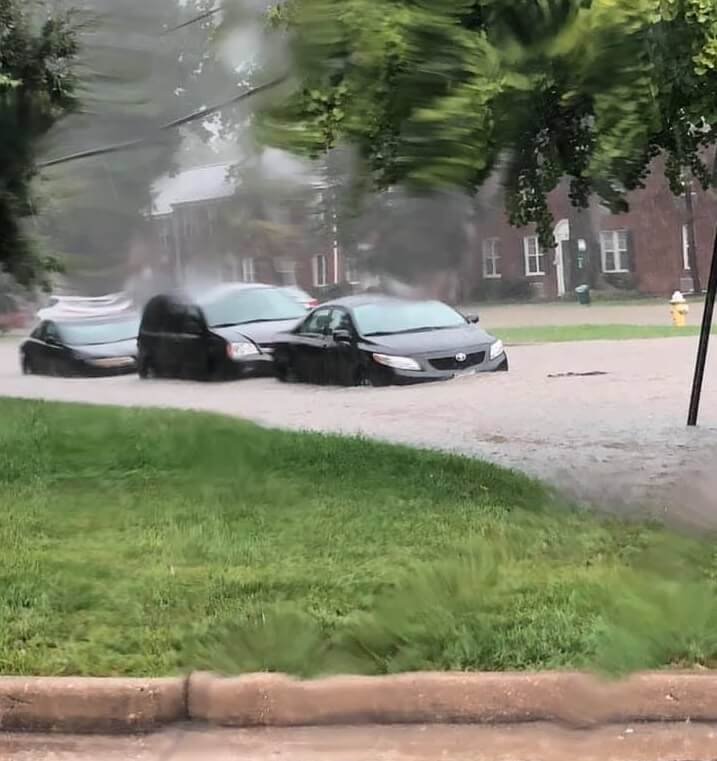
A look at Alexandria's Commonwealth Avenue after the Sept. flood.
Climate change and a lack of repairs blamed for city’s flooding issues
ALEXANDRIA-In July 2019, LaMonica Johnston’s 7-week-old son almost drowned in her own home. The Alexandria resident fell asleep with her son on the couch, only to wake up to three inches of water covering her ankles.
“In less than 10 more minutes, there was two feet of water inside the first floor of our home, along with most other homes in the area,” Johnston said. “My infant son sitting next to me almost drowned.”
Johnston was one of many residents who had to get to safety and then return to clean up the damage. For Johnston, her husband and two children, that meant replacing two totaled vehicles and repairing the house’s bottom floor, which had been ruined.
Flash forward to July 2020 and it happened again. Another major storm came through and Alexandria residents found their basements flooded, drywall damaged and faced weeks of repairs. As they cleaned up, it happened a third time. Earlier this month, another storm triggered flood waters.
It’s reached a point where city residents want to see action from local officials. That was the message handed out Tuesday night, as Johnston and other residents spoke at the council meeting. Council members called the work session to discuss solutions.
The two groups see this differently, however. Residents feel delayed maintenance of the city’s storm drain system and overall infrastructure is to blame. Council members feel at least part of the issue stems from climate change, with too much rain falling too quickly for the drains to handle. And then there’s the fact that 20% of the city is a floodplain, according to the city’s website. It might actually be more than that now. The Federal Emergency Management Agency is updating the floodplain maps, but that project won’t be finished until Fall 2022.
What Does The Data Say?
At Tuesday’s meeting, councilmember Amy Jackson acknowledged the residents’ concerns. She was disturbed over the lack of funding given to address the flooding problem. Only $34,000 was allotted throughout the 2018-2020 fiscal years for storm sewer improvement.
“I need the city staff to be knowledgeable and then guide us in the decisions that we should be making that affect our residents daily,” Jackson said.
Part of the problem from the city’s perspective also comes from local homes. Alexandria’s current requirements use a “10-year storm” as a standard for stormwater design. To be clear, that means infrastructure has to be able to handle a storm producing 2.7 inches of rain in an hour or a maximum of 5.3 inches over 24 hours. In a memo to the council before Tuesday’s meeting, city manager Mike Jinks said the three major storms were far beyond that standard, so the stormwater system couldn’t handle all the rain. He also said the age of some local houses was an issue.
“Many older areas of the city have storm sewer infrastructure that was installed decades prior to the current design standards and already lack capacity for even the historical ‘10-year’ storm,” Jinks wrote.
From Sept. 2018 to Aug. 24 of this year, 72 households have been granted up to $2000 each from the City Backflow Preventer Program, which stops rainfall overflow from entering basements through sewers. The city received over 600 service requests this summer — over half due to the flooding on Sept. 10.
So What’s The Solution?
The city’s Transportation and Environmental Services suggested residents invest in flood insurance and flood proof their homes. Residents meanwhile pointed out they’ve already done those things and it still didn’t help.
“Unfortunately, flood insurance doesn’t cover the cost of hotels, so people need to find alternative lodging or lose thousands more,” resident Jeff Reczek said during the meeting. “It took leveraging every connection we had last year to find places for my family.”
In his memo to the council, Jinks said the realistic option is to speed up some of the projects planned over the next decade. He’s referring to the $2.1 billion Capital Improvement Program the city council signed off on last April. That 10-year project included $150 million for stormwater and sanitary sewer repairs. Also, Alexandria Renew Enterprises, the city’s sewer authority, has another $593 million in projects planned. That mainly involves renovations to the system serving Old Town. But projects five to 10 years down the road won’t help now.
“With climate change and the evident increase in major intense rain events which have caused major flooding, the city will need to reexamine and accelerate its stormwater planning and project implementation,” Jinks wrote in his memo.
What Are The Next Steps?
As a way to help address the problem, the council agreed to several things Tuesday. They plan to increase funding by 20% for the 2021 fiscal year for projects such as improving local drainage, and for stream and channel maintenance like dredging and removing vegetation. The city council also has $40 million allocated to improve the Four Mile Run and Hooffs Run watersheds, which are the biggest problem areas in terms of flooding.
The council also acknowledged an excessive amount of debris built up around Hooffs Run Culvert after last summer’s flood. No one fully cleared that away. The debris only made things worse in the storms that followed. To fix that, the council set aside $2 million to pay for cleaning and repair. That project will start this fall and last for six months.
On Tuesday, Councilmember Mohamed Seifeldein asked Transportation and Environmental Services officials to inspect other infrastructure as well.
As of now, the city inspects infrastructure of this type every two years. Seifeldein said that is not enough. He asked city staff what their policy is to make sure that “our infrastructure is up to par and is not breaking down, so we can avoid issues like this.”
Finally, the group agreed to discuss at a later meeting the need to possibly consider new design standards. If major storms are coming more often, then a stronger stormwater system might help.
Residents Say They’re Still Skeptical
Residents at Tuesday night’s meeting felt there was plenty of talking, but not enough actually decided. Basically, they want solutions now that help them stay in their homes.
“What I’m still missing in this discussion is an explanation of what the actual fix is,” Reczek said. “If additional work is not completed for a few years, what better temporary solutions are available so that my neighbors don’t have to have three feet of water in their kitchens, and we can live in our homes all year around?”
City officials said they’re applying for state and federal grants to speed up projects and create new grant programs for homeowners to flood-proof their homes.
Hannah Parker is a freelance reporter with Dogwood. You can reach her at [email protected].
Politics

It’s official: Your boss has to give you time off to recover from childbirth or get an abortion
Originally published by The 19th In what could be a groundbreaking shift in American workplaces, most employees across the country will now have...

Trump says he’s pro-worker. His record says otherwise.
During his time on the campaign trail, Donald Trump has sought to refashion his record and image as being a pro-worker candidate—one that wants to...
Local News

Virginia verses: Celebrating 5 poetic icons for National Poetry Month
There’s no shortage of great writers when it comes to our commonwealth. From the haunting verses of Edgar Allan Poe, who found solace in Richmond's...

Join the fun: Recapping Family Literacy Night’s storybook adventures
When’s the last time you read a book aloud with a loved one? If it’s difficult to answer that question, then maybe it’s time to dust off that TBR...




